Founded in spring 2010, Cubitek is a relative newcomer to the chassis industry, but that's not stopping it from challenging the biggest names in the business -- including veteran Lian Li. Last month, the company unveiled its latest ICE series with five premium models spanning everything from Mini-ITX to HPTX.
The most affordable is the Mini-ICE, which runs $170 and supports Mini-ITX boards. Next up is the $260 Micro-ICE for MicroATX boards. That's followed by the ATX-ICE ($280), which, as you probably guessed, supports ATX boards. Larger still is the EATX-ICE for $320, which handles up to and including EATX.

If that's not big enough for you, Cubitek offers the $360 HPTX-ICE, which stands 559mm (22") tall and 613mm (24") long. All of the ICE series chassis feature a 2.5mm aluminum construction and Cubitek says this makes them stronger than standard aluminum cases while maintaining a thin and light figure.
Given our preference for full tower chassis like Cooler Master's HAF X and Storm Trooper, it should come as little surprise that we're reviewing the heftiest of Cubitek's new arrivals. We're also interested in the largest model as few enclosures support EVGA's HPTX form factor (mostly just Lian Li cases).
Besides, at $360, the HPTX-ICE is among the priciest cases around, so we're expecting good things -- though the competition is certainly stiff. Lian Li's PC-V2120 is $350, and it left a strong impression when we reviewed in 2010. Let's move on and see what the HPTX-ICE is made of -- literally and figuratively...
External Design
Cubitek uses a clean and minimalistic design for all its ICE cases. As previously noted, the HPTX-ICE measures 559mm (22") tall, 613mm (24") long and 230mm (9") wide, and weighs 19.6lbs (8.9kg) when empty, which is surprisingly light for its dimensions.
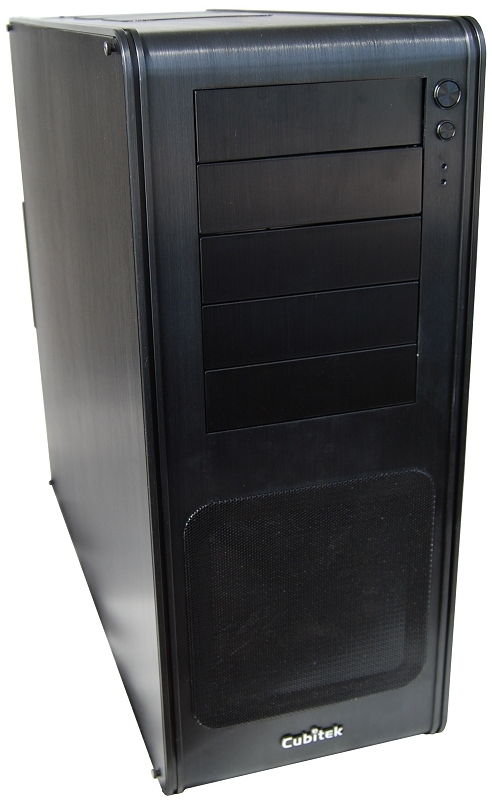


In front, it has a sleek brushed black aluminum bezel with a large fan grill and five 5.25" drive bays. While front panel connectivity is found on top of the case, power and reset buttons along with activity lights are up front. I/O includes two USB 2.0 and USB 3.0 ports along with headphone and mic jacks. Also on the top of the HPTX-ICE are two fan grills similar to the grill on the front.

The 5.25" drive bay covers look great, but almost every time I grabbed the case to move it around they would press in, often falling inside. This introduced another annoying aspect of the HPTX-ICE: you have to remove four screws per door.
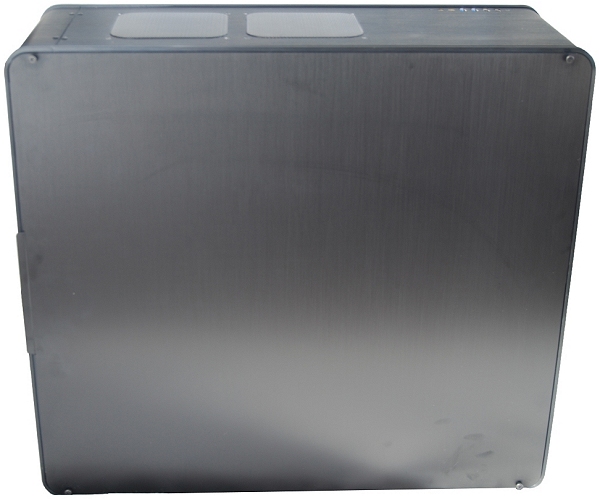
While most case doors feature clips every few inches around the perimeter to ensure a tight fit, the HPTX-ICE simply relies on one screw per corner. This is annoying in and of itself, but it's more than just an inconvenience.
Once hardware is installed, cables pressing even gently on the door cause it to buckle outwards. This leaves the HPTX-ICE looking unattractive and we spent quite a lot of time trying to tuck the cables away to avoid this issue. The doors are bland with no distinguishable features, though they blend into the design well -- if you can get them to sit flush, that is.

We also dislike Cubitek's use of four pop rivots to connect the back panel to the panel that covers the top and front of the chassis. This isn't necessarily bad, but the panels don't align correctly, giving the impression of poor craftsmanship.
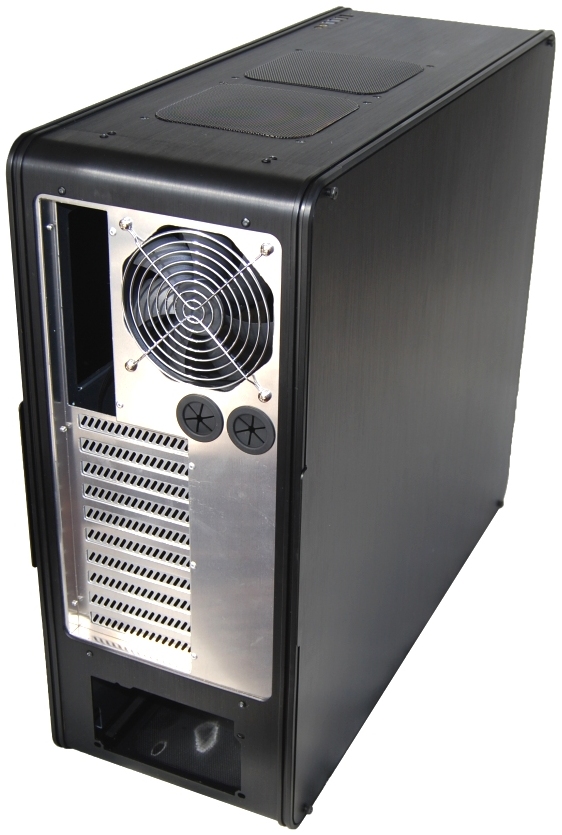
Nevertheless, the back is quite clean with a polished aluminum insert that houses the motherboard's I/O panel, a rear fan, water cooling holes and ten expansion brackets. At the bottom is a bracket for an ATX power supply.
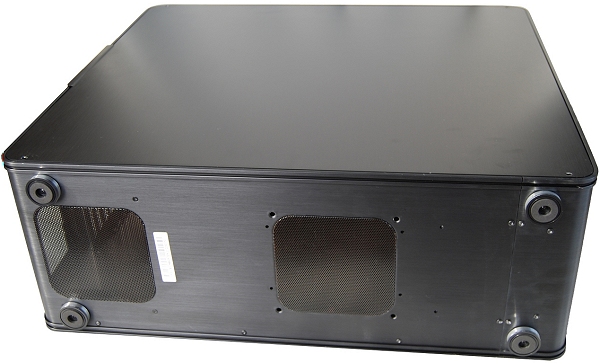
Overall, the HPTX-ICE's external design isn't bad, it just lacks refinement as noted with how the doors and panels attach. Given the case's size and price, Cubitek had room to come up with a more intelligent means of accomplishing both.
Internal Design
As mentioned, getting inside the Cubitek HPTX-ICE requires you to undo four small thumbscrews, which allows the door to be fully removed. This is easy enough to do, but it's more time consuming than it has to be.
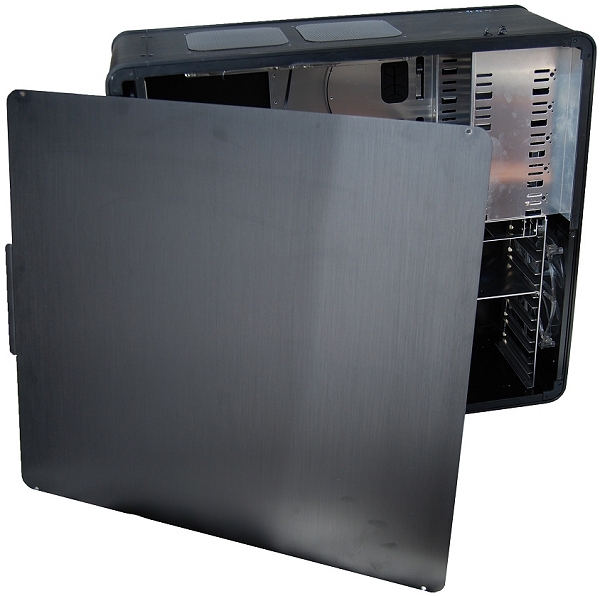
Inside, you'll find a massive motherboard tray that is non-removable -- though that's okay, given how spacious the HPTX-ICE is. Towards the front are seven 3.5" drive bays with one 3.5" to 2.5" adapter for a pair of SSDs.


Above the HDD bays are five 5.25" bays and the bottom two are populated with an adapter for another two 3.5" drives. In total, the HPTX-ICE supports five 5.25" drives, nine 3.5" drives and two 2.5" drives out of the box.
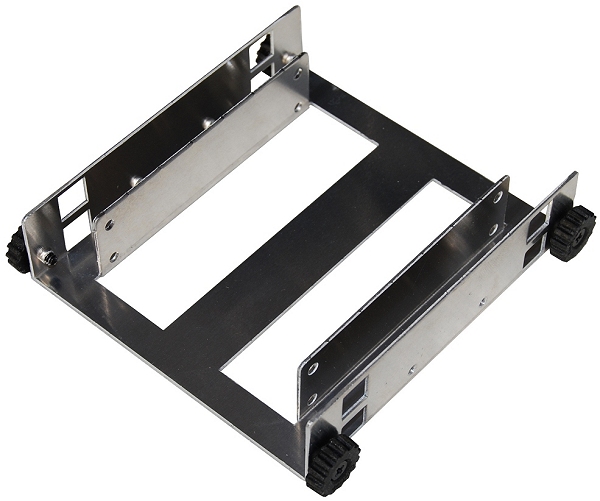


Moving to the back, there are ten ventilated expansion brackets and a power supply mount. There's also a 120mm black fan that uses a 3-pin power connector and is rated at 38.83 CFM. Speaking of fans, there's also a front-mounted 200mm blue LED intake fan with a flow rate of 57.76 CFM.

Cubitek also installed a pair of 140mm blue LED fans into the top of the case, and while they call these "outflow" fans, our review sample came with one mounted as an intake and the other as an exhaust. Both are rated at 49.05 CFM and use a 3-pin connector.
If that's not enough airflow, you can install a 140mm fan in the bottom of the case. Alternatively, the movable 3.5" hard drive cage can be placed here, freeing up the 5.25" bay area. Even with the HDD cage at the bottom, the HPTX-ICE has enough room for a 220m (8.6") long PSU, which covers just about everything available.
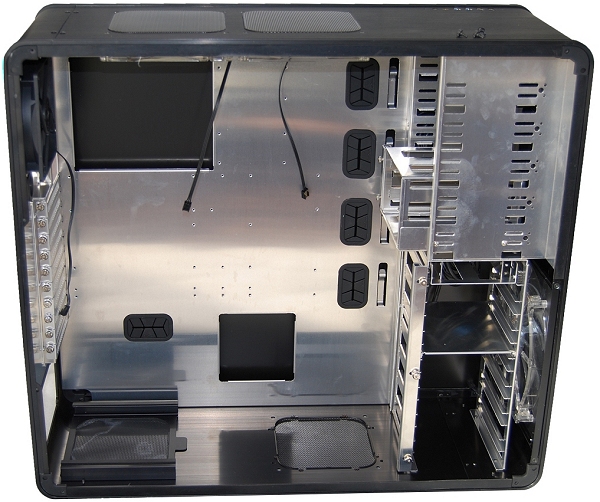
The case also has 17" (433mm) for graphics cards, loads of space considering the longest cards only measure around 11". Likewise, CPU coolers up to 7" (180mm) tall are covered.

For its size, the HPTX-ICE seems a little stingy on cable management. Unlike the Corsair 800D, the HPTX-ICE's motherboard tray doesn't provide holes for ATX boards, so cables have to stretch further than they should. There also isn't as much room behind the motherboard tray as we would've liked. Companies such as Cooler Master solve this issue by being creative with concaved doors.
The HPTX-ICE is also missing a fan speed controller and some form of a tool-less design. Although Cubitek says it provides anti-vibration and tool-less elements for the hard drives, this is not entirely true. There is an anti-vibration design, but it's far from tool-less. Each drive requires four screws and four rubber grommets before being installed, and that calls for a screwdriver. That said, we like the anti-vibration implementation and tool-less or not, it works well.
No comments:
Post a Comment